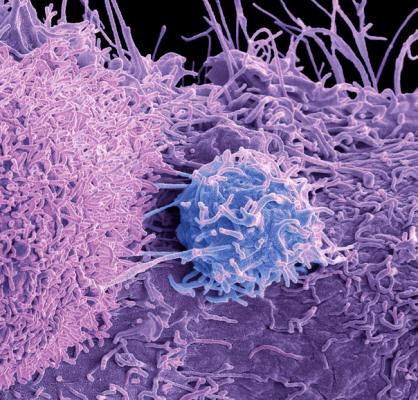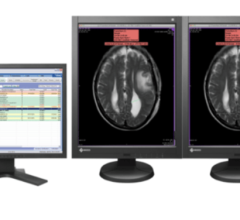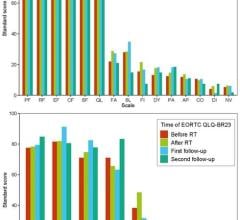
Getty Images
June 29, 2023 — Blue Earth Therapeutics, a Bracco company and emerging leader in the development of innovative next generation therapeutic radiopharmaceuticals, today announced highlights from early clinical and preclinical studies of 177Lu-rhPSMA-10.1 by the Company and a collaborator at the Society of Nuclear Medicine and Molecular Imaging (SNMMI) Annual Meeting, June 24 – 27, 2023. 177Lu-rhPSMA-10.1 is an investigational radiohybrid (rh) Prostate-Specific Membrane Antigen-targeted therapeutic radiopharmaceutical for the treatment of prostate cancer. The presentations included results from an independent clinical study conducted by the University of Augsburg that investigated dosimetry and the therapeutic index for 177Lu-rhPSMA-10.1. Also being presented are results of Blue Earth Therapeutics’ preclinical studies that examined the therapeutic dose response of 177Lu-rhPSMA-10.1 and the therapeutic efficacy of 177Lu-rhPSMA-10.1 as compared to several other compounds. 177Lu-rhPSMA-10.1 is the first clinical candidate in Blue Earth Therapeutics’ oncology development program of advanced targeted therapeutic radiopharmaceuticals. An investigational Phase 1/2 clinical trial (NCT05413850) evaluating the safety, tolerability, dosimetry and anti-tumor activity of 177Lu-rhPSMA-10.1 in eligible men with metastatic castrate-resistant prostate cancer (mCRPC) is underway in the United States.
“We are pleased to share these initial results from Blue Earth Therapeutics’ rhPSMA-10.1 program in prostate cancer with the nuclear medicine community at the SNMMI 2023 Annual Meeting,” said David E. Gauden, D.Phil., Chief Executive Officer of the Company. “Our goal at Blue Earth Therapeutics is to deliver precise, targeted therapy specific to the patient’s condition. The radiohybrid PSMA theranostic technology platform enables molecules within the class to be modified and deployed for either diagnostic PET imaging or therapeutic applications, and can also be developed with both beta- and alpha-emitting therapeutic radioisotopes. Our lead therapeutic compound, 177Lu-rhPSMA-10.1, was carefully optimized during development with the aim of maximizing its therapeutic index by delivering high radiation doses to prostate cancer lesions while sparing normal tissues as far as possible. The preclinical efficacy results in prostate cancer xenografts reported here support a promising therapeutic profile for 177Lu-rhPSMA-10.1. They are further supported by the early clinical experience of our collaborators in Augsburg, where the team observed an average 3.3-fold higher tumor absorbed radiation dose compared to PSMA-I&T in a direct intra-patient comparison, without a proportional increase in radiation dose to the kidney."
Highlights of the presentations
Improved therapeutic index with the novel PSMA-ligand 177Lu-rhPSMA-10.1 compared to 177Lu-PSMA I&T – an intrapatient comparison
Results from an independent clinical study by BET collaborators at University Hospital Augsburg, Augsburg, Germany, were presented by Ralph Bundschuh, MD, PhD, Nuclear Medicine, Faculty of Medicine. The study was designed to evaluate and compare dosimetry and therapeutic indices for 177Lu-rhPSMA-10.1 and 177Lu-PSMA I&T. It included 4 patients with advanced, histologically confirmed metastatic castrate resistant prostate cancer, each patient received 177Lu-rhPSMA-10.1 (1.06 ± 0.05 GBq) and 177Lu-PSMA-I&T (1.09 ± 0.02 GBq), within 2 subsequent weeks. Dosimetry studies were performed to assess whole body uptake as well as, more specifically, uptake in salivary glands, kidneys, liver, spleen, bone marrow and up to 4 tumor lesions. The therapeutic index (TI), the ratio between mean dose to the metastases and the mean dose to the kidneys, was calculated for each patient.
The effective whole-body dose was found to be (0.038 ± 0.008) Sv/GBq for 177Lu-rhPSMA-10.1 and thus higher than for 177Lu-PSMA-I&T (0.022 ± 0.005) Sv/GBq, mainly due to 50% higher dose to the kidneys with (0.69 ± 0.30) Gy/GBq for 177Lu-rhPSMA-10.1 vs. (0.46 ± 0.11) Gy/GBq for 177Lu-PSMA-I&T. Bone marrow doses were (0.07 ± 0.06) Gy/GBq for 177Lu-rhPSMA-10.1 vs. (0.04 ± 0.04) Gy/GBq for 177Lu-PSMA-I&T, while doses to the salivary glands were (0.43 ± 0.18) Gy/GBq for 177Lu-rhPSMA-10.1 vs. (0.13 ± 0.04) Gy/GBq for 177Lu-PSMA-I&T. Tumor doses were significantly higher with 177Lu-rhPSMA-10.1 than 177Lu-PSMA-I&T. Across each evaluated lesion, 177Lu-rhPSMA-10.1 delivered an average of 3.3 times (1.2-8.3) higher tumor absorbed radiation dose. The TI was higher for 177Lu-rhPSMA-10.1 compared with 177Lu-PSMA-I&T (Patient 1, 43%, Patient 2, 213%, Patient 3, 70%, Patient 4, 6.4%) in all cases. Based on these initial results, the use of 177Lu-rhPSMA-10.1 has the potential to increase the tumor absorbed dose and improve the TI. An improved TI gives the option of maximizing tumor absorbed radiation doses, or, in earlier disease, reducing the radiation exposure to normal organs while still achieving an effective tumor dose. They noted that careful assessment of kidney and salivary gland organ function in prospective clinical trials is necessary.
Enhanced therapeutic response to 177Lu-rhPSMA-10.1 in preclinical models of prostate cancer
Caroline Foxton, Ph.D., Blue Earth Therapeutics, Oxford, UK, presented data from preclinical models of prostate cancer designed to evaluate the therapeutic response to 177Lu-rhPSMA-10.1 using several radiation dose levels, and compare the efficacy of 177Lu-rhPSMA-10.1 to 177Lu-PSMA-617 and 177Lu-PSMA-I&T. Results showed that in LNCaP xenografts a single dose of 177Lu-rhPSMA-10.1 significantly suppressed tumor growth (from day 11, p<0.05, to day 32, p<0.0001) and prolonged survival (p=0.001) at all doses tested (15, 30 or 45MBq) compared with controls. Tumor growth was significantly reduced with 30 MBq and 45 MBq compared with 15 MBq of 177Lu-rhPSMA-10.1 (from day 35, p=0.001, to day 49, p<0.0001), suggesting a dose-response effect. Median survival was 28 days for vehicle control and was not reached for the 177Lu-rhPSMA-10.1 groups at the study endpoint and all dose levels of 177Lu-rhPSMA-10.1 were well-tolerated.
In 22Rv1 xenografts, both 177Lu-rhPSMA-10.1 and 177Lu-PSMA-617 significantly suppressed tumor growth (from day 18 onwards, p<0.05, to day 35, p<0.0001) and prolonged survival (p≤0.01) compared with vehicle control. 177Lu-PSMA-I&T inhibited tumor growth to a lesser extent (from day 25 onwards, p<0.05, to day 35, p<0.0001). When compared with 177Lu-PSMA-I&T, 177Lu-rhPSMA-10.1 significantly reduced tumor growth from day 32 onwards (p<0.05) to day 49 (p<0.0001), whereas 177Lu-PSMA-617 significantly reduced tumor growth on day 49 only (p<0.05). Median survival was 33.5 days for vehicle control, 44 days for 177Lu-PSMA-I&T and was not reached for the 177Lu-rhPSMA-10.1 and 177Lu-PSMA-617 groups. All treatments were well-tolerated. The authors concluded that the analyses demonstrate significant therapeutic efficacy with 177Lu-rhPSMA-10.1 in prostate cancer xenografts, at clinically and sub-clinically equivalent dose levels. They noted that the promising therapeutic profile observed for 177Lu-rhPSMA-10.1 compared with 177Lu-PSMA-617 and 177Lu-PSMA-I&T further supports its clinical development.
About Radiohybrid Prostate-Specific Membrane Antigen (rhPSMA)
Radiohybrid Prostate-Specific Membrane Antigen (rhPSMA) compounds consist of a radiohybrid (“rh”) Prostate-Specific Membrane Antigen-targeted receptor ligand, which attaches to and is internalized by prostate cancer cells, which can be radiolabeled with imaging isotopes for PET imaging, or with therapeutic isotopes for therapeutic use – providing the potential for creating a true theranostic technology. Radiohybrid technology and rhPSMA originated from the Technical University of Munich, Germany. Blue Earth Diagnostics acquired exclusive, worldwide rights to rhPSMA diagnostic imaging technology from Scintomics GmbH in 2018, and therapeutic rights in 2020, and sublicensed the therapeutic application to its sister company Blue Earth Therapeutics. Blue Earth Diagnostics received U.S. Food and Drug Administration approval for its radiohybrid PSMA PET diagnostic imaging product for use in prostate cancer in 2023. rhPSMA compounds for potential therapeutic use are investigational and have not received regulatory approval.
For more information: www.blueearththerapeutics.com
Related Medical Radioisotopes Content:
Update on Unplanned Outage of the HFR Reactor
SNMMI Issues Alert That HFR Outage Will Impact Isotope Supply
How Nuclear Fusion is Revolutionizing Medical Isotope Production
FDA Approves Additional Molybdenum-99 (Mo-99) Filling Lines at NorthStar Medical Radioisotopes
Medical Isotope Industry Opposes Export of Highly Enriched Uranium for IRE
IBA and NorthStar Medical Radioisotopes Expand Collaboration to Enable Global Availability of Tc-99m


 April 17, 2024
April 17, 2024 








![(A) PET images of [68Ga]Ga-DOTA-ZCAM241 uptake at baseline and 3, 7, and 12 days after injection as inflammatory arthritis developed in single representative individual mouse. Images are normalized to SUV of 0.5 for direct comparison between time points. (B) CD69 immunofluorescence Sytox (Thermo Fisher Scientific) staining of joints of representative animals during matching time points.](/sites/default/files/styles/feed_medium/public/PET%20Tracers.jpeg?itok=P5Di6MIe)